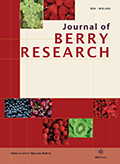Authors: Pope, T. | Gundalai, E. | Elliott, L. | Blackshaw, R. | Hough, G. | Wood, A. | Bennison, J. | Prince, G. | Chandler, D.
Article Type:
Research Article
Abstract:
BACKGROUND: Vine weevil (Otiorhynchus sulcatus) is a major pest of soft fruit and ornamental crops. There is an urgent need to improve control of vine weevil and in particular to provide growers with effective Integrated Pest Management-compatible controls with which to target the adult stage of this pest. One approach would be to exploit the behaviour of adult vine weevil to disseminate spores of an entomopathogenic fungus placed within the crop environment in artificial refuges. To be effective this approach requires that the weevils move through the crop environment and in doing so spread the pathogen from the artificial
…refuges. OBJECTIVE: Use passive radio frequency identification (RFID) tags to study the movement of adult vine weevil within crop environments. METHOD: A series of laboratory bioassays were completed in which the effect of attaching RFID tags using a thermoplastic or a cyanoacrylate adhesive on survival and movement, on both horizontal and vertical surfaces, of adult vine weevil was determined. An outdoor field experiment was then completed at Harper Adams University in order to test the potential of this technique for studying vine weevil movement within crop environments. RESULTS: Attaching RFID tags using the thermoplastic adhesive did not result in any weevil deaths over a 21 day period. In contrast, just over half (53%) of the weevils to which the RFID tag was attached using the cyanoacrylate adhesive died over the same period. The mean of weevil horizontal movement speed was significantly slower when an RFID tag was attached using a thermoplastic (1.01 cm/s) or a cyanoacrylate (0.29 cm/s) adhesive compared with untagged weevils (1.83 cm/s). However, weevils that were tagged using the thermoplastic adhesive were significantly faster than weevils tagged using the cyanoacrylate adhesive. Mean vertical movement speed was also significantly slower when weevils were tagged using the thermoplastic adhesive (0.18 cm/s) compared with untagged weevils (0.37 cm/s). Weevils tagged using the cyanoacrylate adhesive were unable to climb vertical surfaces. In the field experiment, weevils moved away from their release points. Nine days after the start of the experiment weevils were on average 3.38 m from their release points indicating a speed of movement of 0.38 m/day. The mean distance of movement from their release points did not increase further during the rest of the experimental period, but remained relatively constant at between 2.50 and 3.28 m. As such, for weevils that remained within the crop environment, there is no evidence of dispersal behaviour,with movement behaviour observed more likely to be driven by resource utilisation. However, not all weevils remained within the crop area. Indeed, 15 (38%) of released weevils and/or RFID tags left the crop area, indicating possible long range dispersal by these individuals or evidence of predation of the weevils. A total of 11 (28%) of the RFID tagged weevils released into the crop were recovered alive and with the tag still attached after 35 days. These weevils were estimated to have moved a distances of between 2.65 and 17.30 m (average distance moved 7.50 m) during this period. These distances are likely to underestimate the distance moved by each weevil as they assume that each weevil took the most direct route between each point and did not move other than this. In total eight of the RFID-tagged weevils moved both along and between rows of strawberry grow-bags. At the start of the experiment the 11 RFID tagged weevils occupied 11 (14%) of the strawberry grow-bags. If these weevils took the most direct route between each position within the crop where they were detected these weevils would have crossed, and potentially laid eggs in, 44 (58%) of the grow-bags during the 35 days of the experiment. If they had taken a more indirect route the weevils could have potentially laid eggs in a higher number of the grow-bags. CONCLUSIONS: Results presented here indicate that RFID tags can be used to study the movement of vine weevil adults within crop environments. However, the weight and size of currently available tags significantly slows the movement of weevils under laboratory conditions and frequency of detection may affect estimates of actual distance moved. Despite this, the rate at which vine weevil dispersed through the strawberry crop was comparable to the speed of movement recorded previously by others when weevils were released into an urban environment. Use of RFID tags also resulted in detection rates far higher than those reported in studies by others using traditional mark-release-recapture techniques. Use of RFID tags in the present study indicates that adult vine weevil have the potential to disperse spores of a suitable entomopathogenic fungus from artificial refuges throughout the crop environment. Use of this technique could also be applied to investigate the effect of other plant protection products as well as the impact of different cropping systems on vine weevil movement and survival.
Show more
Keywords: Otiorhynchus sulcatus, RFID, remote sensing, tracking, movement, mark-release-recapture
DOI: 10.3233/JBR-150102
Citation: Journal of Berry Research,
vol. 5, no. 4, pp. 197-206, 2015





